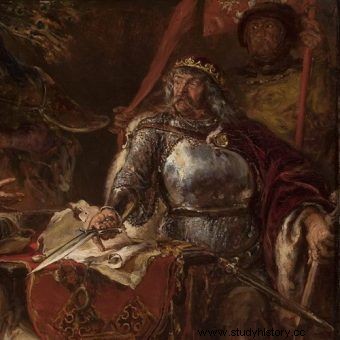
Władysław Łokietek in the painting by Jan Matejko.
Władysław the Short (-1333)
The prince and king of Poland from the Piast dynasty. He was born as a son of the district prince Kazimierz I of Kuyavia, from whom in 1267 he inherited Kujawy Brzeg and Dobrzyń. Initially, the power on his behalf was exercised by his mother, Eufrozyna, then - from 1275 - he was forced to share his patrimony with his brothers. He began his great political career in the late 1980s, taking over Sieradz, and even making an attempt to take control of Krakow. At the turn of the 1980s and 1990s, he married the Greater Poland princess Jadwiga Bolesławówna.
In 1296, after the death of Przemysł II, he took power in Greater Poland. In 1299 he was defeated and chased by the Czech king Wenceslaus II, who then proclaimed himself king of Poland. He returned to the country in 1304, gradually unifying his provinces under his rule. In the years 1311-1312 he struggled with the rebellion of Krakow townspeople, led by the alderman Albert. The position of Władysław the Short was strengthened by his coronation in Kraków in 1320, although this decision was not recognized in Western Europe, where he was referred to as the "king of Kraków".
He devoted the last years of his rule to difficult and mostly unsuccessful fights with the Teutonic Order. He took part in the famous Battle of Płowce, considered a victory and a turning point in the struggle. He died in old age, most likely from a stroke. The nickname Łokietek - coined from the word "elbow" - he received due to his short stature.
His wife, known as Jadwiga of Kalisz, played an important role alongside Władysław. The power of his father was taken over by the only surviving son - Casimir the Great.
